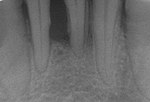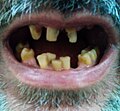A hygroma, or a false bursa, is a discrete, fluid-filled sac that can form on the joints of dogs in response to repeated pressure, such as that from sitting...
3 KB (300 words) - 14:29, 20 September 2023
Hygroma may refer to: Cystic hygroma Subdural hygroma Hygroma (canine disease) – swelling on or near a dog's elbow This disambiguation page lists articles...
149 bytes (49 words) - 23:32, 20 March 2020
Periodontal disease, also known as gum disease, is a set of inflammatory conditions affecting the tissues surrounding the teeth. In its early stage, called...
76 KB (8,691 words) - 11:44, 22 October 2024
Hing–Torack–Dowston syndrome Hinson–Pepys disease Hip dislocation Hip dysplasia Beukes type Hip dysplasia (canine) Hip dysplasia (human) Hip luxation Hip...
21 KB (1,717 words) - 04:04, 12 March 2024
Campylobacteriosis Camurati–Engelmann disease Canavan leukodystrophy Candidiasis Chronic mucocutaneous candidiasis Canga's bead symptom Canine distemper Cannabis dependence...
40 KB (3,657 words) - 03:02, 17 August 2024
Dog health (section Vestibular disease)
are: Rabies CDV (canine distemper) CAV-2 (canine hepatitis virus or adenovirus-2) Canine herpesvirus Canine influenza CPV-2 (canine parvovirus) Kennel...
68 KB (8,040 words) - 02:48, 19 August 2024
Charcot-Marie-Tooth disease. The Saint Bernard is predisposed to several skin conditions, these include: acral lick dermatitis, intertrigo, dermal arteritis, hygroma, and...
36 KB (4,130 words) - 03:21, 19 October 2024
of the teeth, and on tooth surfaces that are adjacent to incisors and canines. Eventually, the coronal tooth area (near the crown) can be affected by...
23 KB (2,395 words) - 01:48, 1 September 2024
Gingival enlargement (category Dog diseases)
in the size of the gingiva (gums). It is a common feature of gingival disease. Gingival enlargement can be caused by a number of factors, including inflammatory...
15 KB (1,612 words) - 19:38, 22 August 2024
dental origin Cystic hygroma Gnathophyma Ludwig's angina Macrostomia Melkersson–Rosenthal syndrome Microstomia Noma Oral Crohn's disease Orofacial granulomatosis...
15 KB (1,867 words) - 14:12, 28 December 2023
chemical or electrical; and which cannot be ascribed to any other dental disease. A degree of dentin sensitivity is normal, but pain is not usually experienced...
27 KB (3,298 words) - 02:57, 19 October 2024
Gingival cyst (category Diseases of oral cavity, salivary glands and jaws)
lingual surface of the alveolar process. It is most commonly seen in the canine and premolar regions of the mandible, and are sometimes confused with lateral...
9 KB (1,061 words) - 23:50, 17 August 2023
enamel layer. For the same reason, larger teeth such as the molars and the canine (cuspid) teeth tend to be darker. Baby teeth (deciduous teeth) are generally...
22 KB (2,393 words) - 09:13, 23 July 2024
anterior teeth has been seen as an adaptation to the heavy use of their canines and incisors in processing and chewing food, and the use of their teeth...
15 KB (1,558 words) - 11:38, 29 October 2024
Retrocuspid papilla (RCP) is a small elevated nodules mostly behind the lower canine teeth in humans(Fig.1,2). It is sometimes associated with reactive arthritis...
5 KB (553 words) - 09:33, 17 August 2024
commonly found in the anterior region of the maxilla12 – usually around the canines.11 The majority of cysts are of inflammatory origin12. They are most commonly...
17 KB (2,216 words) - 02:14, 28 August 2024










